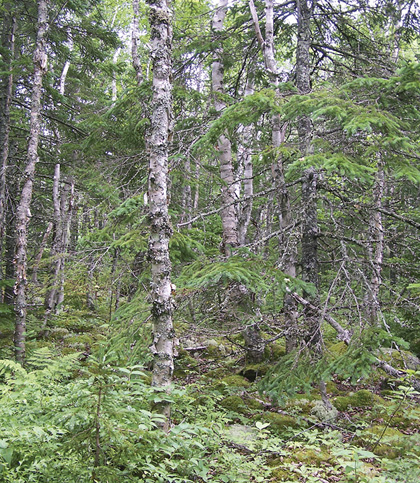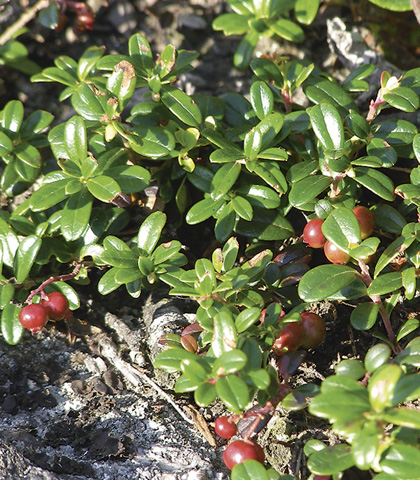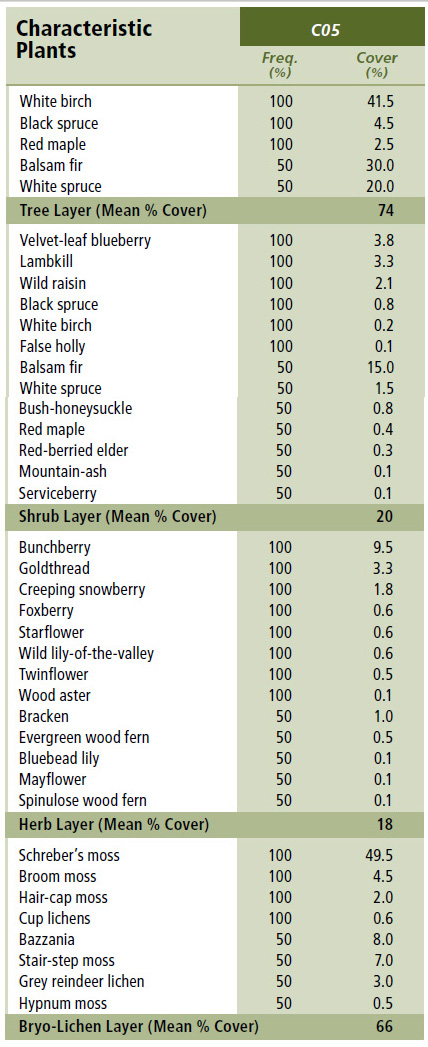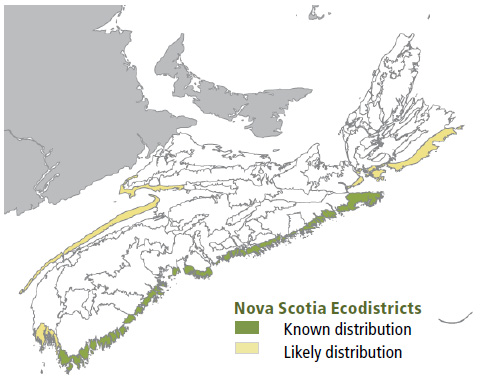
Forest Vegetation types - CO5
CO5 — White birch - Balsam fir / Foxberry - Wood aster
Betula papyrifera - Abies balsamea / Vaccinium vitis-idaea - Aster acuminatus
 |
Waddens Cove, Cape Breton County |
Concept: This mid-successional Vegetation Type (VT) has an overstory dominated by white birch, usually with a strong component of balsam fir. In western Nova Scotia, trembling aspen, red maple and white spruce can also be common in the overstory. Extensive conifer regeneration often dominates the shrub layer. White birch - Balsam fir / Foxberry - Wood aster is usually associated with more sheltered sites across the Atlantic Coastal ecoregion.
Vegetation: White birch is the dominant overstory tree, along with balsam fir and/or white spruce. Scattered red maple and black spruce are also typical and minor amounts of heart-leaf birch — a species usually confined to Nova Scotia's coastal and highland ecoregions — is sometimes in the overstory. The shrub layer is often dominated by regenerating balsam fir. Other shrubs include wild raisin, velvet-leaf blueberry, lambkill, false holly and mountain — ash (which can sometimes attain overstory height and crown breadth). Herb layer diversity is low; only bunchberry, goldthread, creeping snowberry and foxberry are common. The bryophyte layer is well developed for a mixedwood VT, with Schreber's moss the main species. Bazzania cover can also be high where coarse woody debris has accumulated on the forest floor.
Environmental Setting: CO5 is associated with fresh to moist, nutrient medium to rich soils of glacial origin. These soils are generally medium to coarse textured. This VT occurs on relatively well drained upper and middle slopes of gentle terrain along the Atlantic coastline. Sites are generally more sheltered than those associated with softwood dominated VTs in this group (CO1 - CO4). The VT likely occurs in coastal areas of both New Brunswick and Prince Edward Island, but has not been documented.
Successional Dynamics: CO5 is a mid-successional VT dominated by white birch and balsam fir and/or white spruce. This even-aged VT typically follows stand-replacing disturbances such as windthrow, breakage, insect infestation and harvesting. Although still influenced by wind and exposure, like other coastal VTs, increased shelter allows hardwood tree species to rise above or co-dominate the canopy with softwoods on CO5 sites. Depending on the disturbance agent and its return interval, and on the degree of sheltering, CO5 may succeed to CO6 (Red maple - White birch / Bunchberry - Sarsaparilla) or transition to CO4 (Balsam fir / Foxberry - Twinflower).
Ecological Features: This mixedwood patch forest of white birch, red maple and balsam fir is primarily associated with the Maritime Boreal Atlantic Coastal ecoregion. It is usually found inland, protected by seaward stands of spruce and fir forest or on sites sheltered from coastal winds and salt spray. The short longevity and shade intolerance of white birch, relative to red maple,can produce uneven-aged canopy structures. Older stands with balsam fir may have the endangered boreal felt lichen and other uncommon cyanolichens.
 |
| Foxberry (Breagh Quigley) |
Distinguishing Features: White birch and balsam fir are common in the overstory of this coastal mixedwood forest. The presence of mountain-ash, heart-leaf birch, foxberry and bazzania are indicators of a coastal influence though not always present. Wood aster is common. Moss coverage on the forest floor is still extensive even with the hardwood overstory.
| Slope Position: | Middle5 Upper5 |
Surface Stoniness: |
(Very - Excessively)10 |
Bedrock Outcrop: |
(Non-rocky)5 (Slightly - Moderately)5 |
Elevation Range: |
17 - 24m |
Slope Gradient: |
Gentle5 Moderate5 |
Aspect: |
West10 |
Exposure: |
Exposed5 Mod. exposed5 |
Microtopography: |
Levelv Slightly5 |
Drainage: |
Well10 |
Soil Type: |
ST25 ST2-L5 |
Parent Material: |
Glacial till5 Till/Bedrock5 |
Rooting Depth (cm): |
(30-45)10 |
Duff Thickness (cm): |
(0-5)10 |

